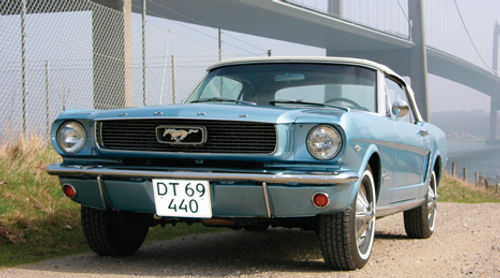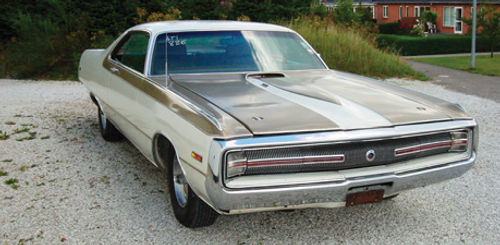A Restorer’s Story A 1965 Mustang In Denmark
There’s a Surprising Number of U.S. Cars There.
EDITOR’S NOTE: WHILE going through the Mechanic on Duty inquiries this month, one email in particular jumped out at me. In this instance, the reader was looking for information on the “products and methods” used by the Big Three automakers to coat frames in the 1960s and ’70s. (For the particulars and the response, check out the last entry on page 8.) But what really caught my attention was the signature on the reader’s note: “Jeppe Groenlykke, Denmark, Europe.”
We seldom get correspondence from overseas, and I can’t recall when, if ever, we received a note from Denmark. In all honesty, we at Auto Restorer know little about Denmark, other than that the capital is Copenhagen and that land is the home of Shakespeare’s “Hamlet.”
So, we saw this as an opportunity to find out more about Denmark and, of course, since Jeppe is a restoration enthusiast, it was a chance to learn about the state of the vintage vehicle hobby in his country. What follows is a volley of emails between us and Jeppe that helped to illustrate the far-reaching nature of the vintage vehicle hobby and, among other things, showed us that Denmark isn’t quite as cold in the winter as we thought
AR: Why don’t we start with some information about Denmark. I was looking at a map (there’s one on the next page) and it appears that the country is made up of a peninsula and numerous islands. Also, I see from the images you sent in that one of your cars is a Mustang convertible. Is the top-down, summer driving season fairly brief in Denmark and winter pretty rugged or is that just a stereotype dreamed up by folks unfamiliar with the region.
Jeppe: First of all,thank you for a great magazine. I am more than happy to give you some information about this little country, and I think it would be great fun if the pictures of my cars made it to the printed pages.
As you wrote, Denmark consists of two bigger islands and a peninsula (and a bunch of smaller islands). I live on the middle island, Funen, between Jutland (the peninsula) and Zealand (the biggest of the two islands and with the capital Copenhagen). I live on a farm just 30 minutes south of Odense, the birthplace of the writer Hans Christian Andersen.

The picture with the water in the background (on this page) is taken on a levee that leads to one of the smaller islands near my home.
The water in the background is “Little Belt,” the strait between Jutland and Funen. Little Belt is connected with the Baltic Sea.
The bridge in the (other photo on this page)stretches across LittleBelt and connects Funen with Jutland. It’s a highway bridge and is used by many commuters each day.
Well, the weather isn’t so bad in Denmark (even though one occasionally wishes to be in Southern France or Spain during the winter). We have a cold winter, yes, but not as bad as the New York area this past winter! Generally the temperature is between 14° and 45° F in the winter. Pleasant summer days with 70° to 80° F would generally be from around the end of May through the end of September, though it also can be rainy sometimes in the summer.
AR: Are there many vintage vehicles in Denmark and, specifically, do you see many American cars on the roads.
Jeppe: I believe there is a vivid interest for vintage cars in general among the Danish population. With respect to American cars, yes, I think there are many of them given the size of the population. For instance, the Danish FordMustangClub counts 1500 members and 1600 vehicles (out of a national population of 5.5 million). It is estimated that 100,000 Danes have historical vehicles as a hobby.
The American cars have clearly gained in popularity the past 15 years. Only a small number of these cars were imported as new back in the days, so many Danes view them as very exotic cars!

Personally, I currently own a 1965 Mustang convertible and a 1970 Chrysler 300 Hurst (a project in the waiting). Only a shortage of time prevents my collection from growing.
The Mustang was pretty much in the condition that you see in the photos when I bought it some years ago. It is a California car first sold from Ames Ford in San Rafael.
Apart from what I believe is a recent repaint and a refurbished interior it seems to be a pretty original car. Every time I get to work on the car I check the various parts’ date codes. They are all in line with the production date of the car.
During the summer this car qualifies as my daily driver.When I’m not driving my real car (i.e. the Mustang) I have a new Honda Accord. Boring thing…
AR: Tell us about the price of cars and gasoline in Denmark.
Jeppe: When it comes to cars, Denmark is a difficult country.I love the country because I was born here. It is a pretty and safe country but you may have heard that our taxes are high. In fact we have a standing world record! That part about the country I do NOT like! But that’s the way it is and cars are no exception; neither is gasoline. Both are heavily taxed.
Denmark has never had an automobile industry, so it has always been convenient for the politicians to regard cars as luxury items. In our two neighbor countries, Germany and Sweden, which both have well-established automotive industries, the price for a new car is about half of what we pay or less.
If you buy a new car in Denmark two thirds of the price is taxes. I’m not kidding you. For example, if the import price of a new car is 50,000 USD (U.S. dollars) the amount the consumer would have to cough up would be around 170,000 USD.
I just checked the retail price of a new Cadillac CTS 6.2 V-8 Supercharged Sport Luxury with a manual transmission. It is 1,587,457 Danish Kroners which translates to approximately 300,000 USD, just to get you the picture. A Porsche 911 Turbo is 3,201,984 DKK (610,000 USD).
Gasoline prices are about the same throughout Western and Northern Europe. The current price is about 12 DKK per litre regular RON 95 which is 8.65 USDa gallon. Measured in real pricesthe gasoline price has been pretty stable the past five to 10 years. Of course, prices fluctuate with the world market price of oil.
AR: Your English is quite good and you’re obviously very interested in American iron. Did you ever live in the U.S.?
Jeppe: Thanks for the nice words on my English. I appreciate it. How did I learn it? Well, you are everywhere! Turn on the news—U.S. President. Go to the cinema—Hollywood stuff. Sit back in the couch to enjoy an evening in front of the television—American sitcoms, etc.
Besides, when your mother tongue is spoken by a mere five million people (I heard somewhere that Danish was used as a code language by some secret agents during WWII) you’re bound to learn foreign languages. In Denmark, English is our first foreign language and is taught from the third grade. Being fascinated by your country I also try to learn about your language as I go. So far, I haven’t had the chance to visit the U.S. But I really would like to and I am looking forward to the one day when it happens.
















